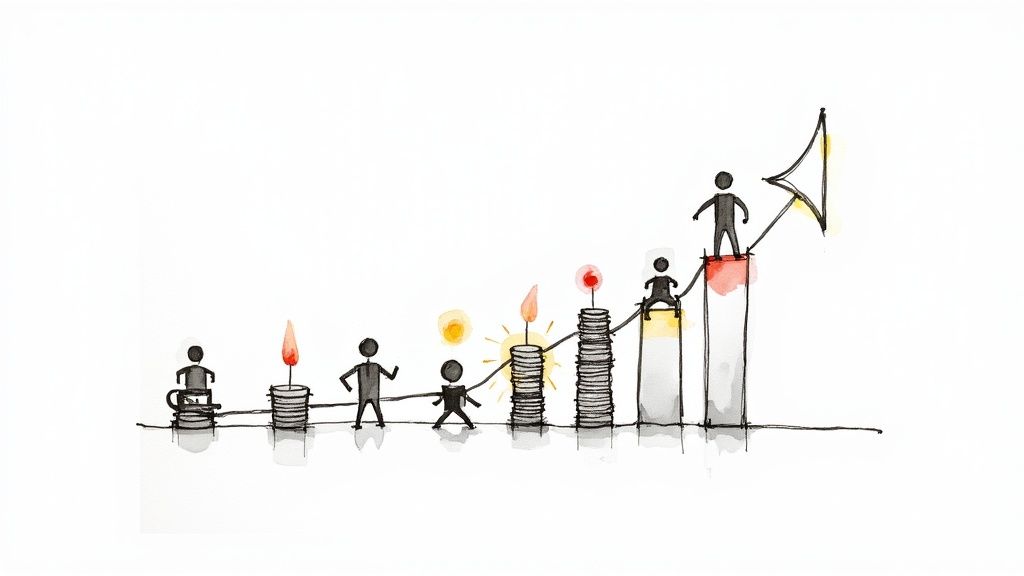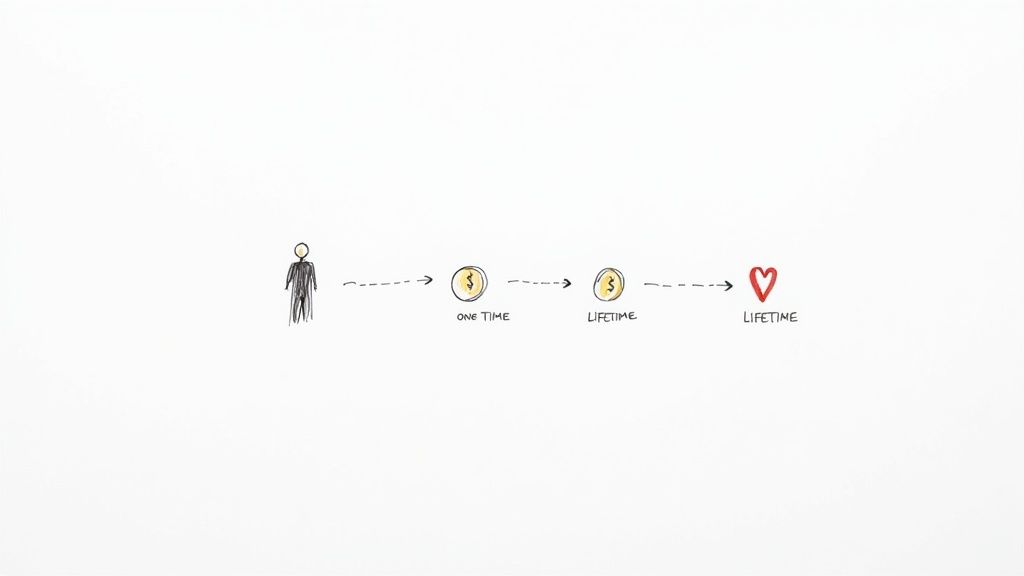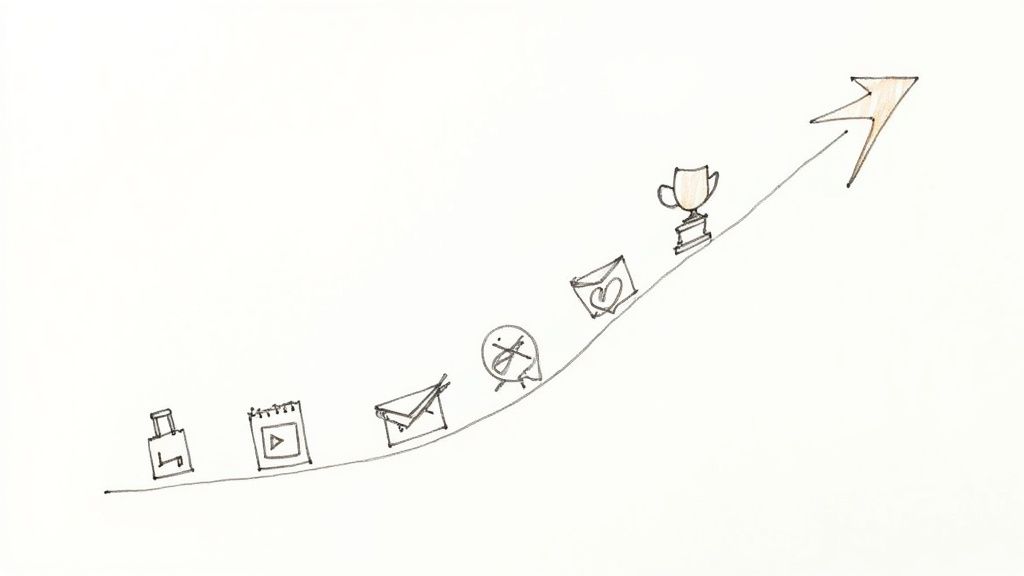
Mastering Lead Generation Best Practices: Strategies for 2026 Success
Master lead generation best practices for 2026 success. Discover strategies, AI tactics, and content approaches to drive qualified leads.

When you calculate customer lifetime value, you're predicting the total money a single customer will spend with your business over their entire relationship with you. It's a shift in perspective—moving beyond a single transaction to look at the long-term relationship.

Think about the difference between a tourist who buys one souvenir and a local who visits your coffee shop every week. Instead of just celebrating today's sale, CLV prompts you to ask, "What is the total value this person is likely to bring us?" This forward-looking approach is a game-changer for making smarter business decisions.
Knowing your CLV influences everything, from your marketing budget to your product development. It's about understanding that some customers are simply more valuable over the long haul. For a more technical breakdown, you can check out this definition of Customer Lifetime Value (LTV).
Calculating CLV is the first step toward identifying your best customers—the ones who buy from you repeatedly. Once you know who they are, you can double down on efforts to keep them happy and engaged. This isn't just a feel-good strategy; it's incredibly profitable. Studies have shown that boosting customer retention by a mere 5% can increase profits anywhere from 25% to 95%.
Focusing on keeping the customers you already have is almost always cheaper than finding new ones. You can see how expensive it is to attract new business in our guide on what is cost per acquisition to understand the contrast.
Ultimately, CLV transforms your strategy from chasing short-term sales to building long-term, sustainable growth. It provides a clear roadmap for investing in relationships that deliver the highest return.
With this number, you can make decisions that directly impact your bottom line, ensuring your resources are spent where they'll make the biggest difference.
Before you can start calculating, you need to gather your raw materials. The good news? You probably already have the essential data in your CRM, e-commerce platform, or sales spreadsheets. The trick is knowing what to look for.
Think of it as a treasure hunt through your business data. You’re looking for three key numbers that are the bedrock of nearly every CLV formula. These aren't complex metrics; they're direct reflections of past customer behavior.
The three puzzle pieces you need are Average Purchase Value, Purchase Frequency, and Customer Lifespan. Each one gives you a different angle on your customer relationships. Getting them usually starts with pulling a simple sales or order history report.
Average Purchase Value (APV): This is how much a customer spends, on average, per purchase. To get this number, divide your total revenue over a set period (like a year) by the total number of orders in that same timeframe.
Purchase Frequency: This tells you how often a typical customer buys from you in that period. Calculate it by dividing the total number of orders by your total number of unique customers.
Customer Lifespan: This is the average time a customer stays with you. For an established business, look at the average time between a customer's first and last purchase.
If you're running on a platform like Shopify, you can find most of this in the "Analytics" or "Reports" section. Reports like "sales by customer" are your best friend here.
What if you're a new business? Figuring out customer lifespan without years of data can feel like guesswork. A solid workaround is to use your churn rate. Just calculate 1 / your monthly churn rate. For instance, if you lose 5% of your customers each month, you can estimate an average lifespan of 20 months (1 / 0.05).
Ready to calculate a real customer lifetime value? The most straightforward place to start is with the historical model. This approach looks at past customer behavior to give you a solid baseline for what your customers are worth.
The go-to formula for this breaks down into three key pieces. As highlighted in Shopify’s guide to long-term profitability, it’s (Average Purchase Value × Purchase Frequency) × Average Customer Lifespan. It's simple yet powerful, showing you where to focus—on getting customers to buy more often or stick around longer.
Let’s make this real. Imagine you run a small online store that sells handmade candles. We can plug in some numbers to see this formula in action.
This concept map helps visualize the different data points you’ll be pulling together for this calculation.

Each element—value, frequency, and lifespan—is a critical piece of the puzzle. A change in any one will directly impact your final CLV.
So, with our candle shop example, the math looks like this:
($40 per order × 3 orders per year) × 2 years = $240This tells you that the average customer is worth $240 in revenue over their entire time with your business. Knowing this number is a game-changer for making smarter spending decisions, especially when you need to calculate marketing ROI.
Looking at past purchases is a great start, but it's like driving while only looking in the rearview mirror. For a more accurate picture of future revenue, we need to shift our focus to predictive models.
These methods forecast what a customer will do, not just what they've already done. This makes them powerful for strategic planning, like figuring out marketing budgets or spotting at-risk customers.
To get this right, you have to accept a simple truth: not every customer will stick around forever. Predictive models bake this reality into the math using two key concepts: churn rate and discount rate.
Let's see how this works with an example. Imagine you run a subscription box service that costs $30 a month. You've figured out that you lose about 10% of your subscribers each month—that's your churn rate.
A straightforward predictive formula divides the average revenue per customer by the churn rate.
For our subscription box, the math is:
$30 (Average Monthly Revenue) / 0.10 (Monthly Churn Rate) = $300 CLV
What does this $300 figure mean? It means you can expect a new subscriber to be worth $300 in total revenue over their relationship with you, before they eventually churn.
This forward-looking approach is a game-changer. It forces you to acknowledge customer churn from day one, giving you a more grounded and actionable estimate of a new customer's worth. This insight helps you make smart decisions on how much to spend to acquire a customer and how much to invest in keeping them.

Calculating your CLV is a great start, but real growth happens when you take action to improve it. You don't need to reinvent the wheel. The secret is focusing on the core levers of the CLV formula: how much customers spend, how often they buy, and how long they stick around.
Even small, deliberate changes in these areas can create a massive ripple effect on your revenue.
One of the most direct ways to lift your CLV is to increase what customers spend per checkout. Smart upselling and cross-selling are your best friends here.
Getting customers to buy from you again is where you build a sustainable business. This is less about transactions and more about building a genuine relationship.
The power of keeping customers happy is staggering. A mere 5% bump in customer retention can increase profits by anywhere from 25% to 95%. Why? Loyal customers simply spend more over their lifetime.
Think about it: a well-designed loyalty program or a personalized email with a special offer can be the nudge someone needs to buy again. Deliver an exceptional experience, and you'll turn a first-time buyer into a loyal advocate.
To dig deeper into keeping customers happy, check out these proven strategies to reduce churn and boost customer retention.
Even with the formulas down, practical questions pop up when you start to calculate customer lifetime value. Getting these common points sorted out will help you build confidence and sidestep simple mistakes.
Let’s dig into a few of the most common questions.
The easiest way to think about it is looking forward versus looking back. CLV is a forecast of the total revenue you expect from a customer over their entire future relationship. It's about their potential value.
Customer Profitability, on the other hand, is a historical metric. It calculates the net profit a customer has already brought in. This means subtracting all costs tied to that customer—from acquisition to support—to see how profitable they've been so far.
So, CLV projects future revenue, while profitability measures past profit.
What do you do when you have no historical data? Without a long history of customer purchases, you have to get creative with educated estimates and early behavioral signals.
A great starting point is to track what customers do in their first 30, 60, or 90 days. This will give you initial clues for average purchase value and frequency. For customer lifespan, you’ll have to lean on industry benchmarks. Find reports on average churn rates for your niche and use that to build a simple predictive model.
It's an iterative process. Your initial CLV might be an educated guess, but it's a starting point you can refine month by month. As you collect your own data, your CLV calculation will get much more accurate.
The ratio of your Customer Lifetime Value to your Customer Acquisition Cost (CLV:CAC) is a critical health check for your business. The gold standard is 3:1.
This means for every $1 you spend to bring in a new customer, you get $3 back in lifetime revenue.
A ratio below 1:1 is a huge red flag—you're losing money on every new customer. On the flip side, a very high ratio, like 5:1, might mean you're not investing enough in marketing and could be leaving growth on the table.
At BrandBooster.ai, we help turn these numbers into real growth strategies. We use data and AI to help you not only figure out your CLV but also build marketing campaigns that attract high-value customers from the start. Learn more about how our outcome-driven approach can grow your business.